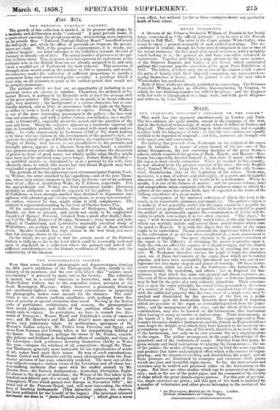2fl Artm.
THE NATIONAL PORTRAIT GALLERY.
The growth of this collection is marked, in its present early stage, by a modesty and deliberation truly "national." A quiet private house in a quiet street contains the pictures up-stairs, with nothing more imposing on its outside than "National Portrait Gallery Board inscribed round the bell-pull; and, while the offers of portraits are frequent, the accept- ances are chary. Still, if the progress is unprecipitate, it is steady, and without languor : our brief reference to the collection towards the end of January is already out of date. The actual number of pictures in the gal- lery is thirty-three. This, however, does not represent its real extent, as the portraits now in the British Museum are already assigned to it, and only await a needful act of Parliament for their removal. This accession of strength alone would send up the number to 100 or upwards, and would, we conceive, render the collection of sufficient proportions to justify a permanent home and unrestricted public scrutiny : a privilege which it were wise on all accounts to grant at the earliest period that would not be actually premature.
The portraits which we had not an opportunity of including in our previous notice are eleven in number. Chambers, the architect of So- merset House is portrayed by Reynolds with at least the average skill of the great painter. The face, pensive in its mood, is in broad reflected light, very masterly ; the background of a sylvan character, but so con- fusedly marked, and so little in accordance with the light on the figure, as rather to seem a freak of experiment or caprice. Ireton, by Walker, is one of the most interesting personages in the gallery ; the face very firm and masculine, and with a rather curious resemblance, on a smaller scale, to Cromwell's, especially about the month and the junction of the eyes and brow. Sharp the engraver appears as a handsome vigorous old man in Lonsdale's portrait, which is executed with much gusto and so- lidity. An early crayon-study by Lawrence (1788 or '89) worth looking at by those who are curious in the development of the painter's style, re- presents the placid old age of Elizabeth Carter, the translator of Epictetus. Wright of Derby, well known to our grandfathers by his portraits and fire-light pieces, appears in a likeness from his own hand ; a sensitive face, prepossessing and rather handsome, and, if we reduce the characters of genius to those of good sense, not wholly unlike what Shelley might have been had he survived some years longer. Robust Bishop Efoaclley- no mortified ascetic—is introduced to us in a portrait by his wife, very efficiently done, to which who knows but that friend Hogarth may have vouchsafed a goodnatured touch or two ?
The portraits of the disciplinarian-eyed circumnavigator Captain Cook, by Webber, the artist attached to his expedition—and of the poet Thom- son, whose easy nature simmers in his face, by Paton—are of an ordinary level of art ; that of Archbishop Wake, by T. Gibson, respectable. Fox the martyrologist and Wolsey are from anonymous hands ; likenesses probably as authentic as could be expected for the gallery. The head of Nollekens—a keen strongly-marked face, destined to degenerate into ugliness with advancing age—is also anonymous, or at any rate contested : its author, whoever he was, might claim it with complacence. The sculptor is represented standing by his bust of Charles James Fox. Of the earlier-acquired portraits, those of Shakspere, Raleigh, and Handel, are first in interest, and surely not easily to be supplanted. Joseph's of Spencer Perceval, (studied from a mask after death,) Ram- say's of Dr. Mead, Dance's of Murphy, Romney's (very broad and indi- vidual) of Cumberland, and Lawrence's unusually excellent study of Wilberforce, are perhaps first in art, though not all of them without rivals. Speaker Lenthall has high claims in the first kind, and more than fair average claims in the second. On the whole, w4 are glad to find the artistic merit of the Portrait Gallery is fully up so far to the level which could be reasonably reckoned upon or stipulated in a collection where the primary and indeed all- sufficient considerations are the historic worthiness of the sitter and the authenticity of the likeness.


































 Previous page
Previous page